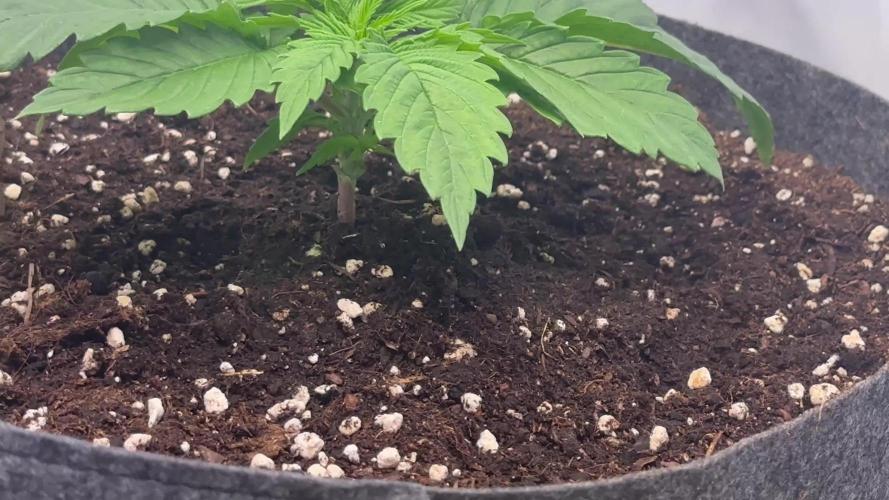The Grow Awards 2026 🏆 

































Likes
41
Share


@Haoss
Follow
This beautiful girl has started to bloom actively, she receives 5 liters of food every day, she feels very well 💚🌋
Likes
5
Share


@Ieiogrow94
Follow
Eccoci qui...
Tutto va per il meglio, questa settimana ho eseguito Lollipopping e Defoliation per far si che le cime principali sprigionino al meglio il loro vigore.
Siamo verso la fine del progetto ora bisogna solo aspettare la fine...
Grazie a tutti per il supporto🔥🌲❤️
Likes
27
Share


@adam_pawloski87
Follow
This week went really great! Plants are looking super healthy today at day 22 from seed!! Today they got a dose of just pure water phd at 6.5 ! Temperature an humidity has been staying pretty stable everyday, staying around 70-75 degrees and 58-61 % humidity!! Can’t wait to see what these girls do this week ! Hope you all enjoy , an had a great safe weekend! Peace love an positive vibes to y’all Cheers 😶🌫️💨💨💨If there’s any questions, please ask me 🙏🏻
Likes
13
Share


@Chuckwaggon420
Follow
Starting to get strong smelling when you move them around. HANDS OFF lol. Will do tea next week coming along nice. Both the pie is was crystaly and #3 runtz is way crystaly! All runtz have big weight, all pie is about the same. Should have a decent harvest!!! Let me know what you guys think!!!
Likes
5
Share


@LeedsCityFarmz
Follow
Plants exploded this week once put into the Scrog. All tops topped once this week to help promote all tops below the main canopy to catch up with the rest.
Likes
77
Share


@SooSan
Follow
Dans l'ordre:
1) Afghan Peach x Blue Monkey
2) Gelato Cake
3) Fast Critical Poison
4) Tropical Fuel
5) Hindu Kush
6) (Blueberry x Black Domina) X (Kosher Kush x Mk-Ultra)
7) Blueberry (Cut =)
8) Herz OG (Cut)
9) (Blueberry x Black Domina) X (Kosher Kush x Mk-Ultra)
Likes
12
Share


@SnarkyGoat
Follow
I wanted to title this weeks grow "How Big Are Your Balls? (root balls that is, lol)". I've been wanting to post pictures and video of the root balls for a while now, so today's the day! The temperature has been dropping here, so the plants are getting much less heat stress. In a couple of weeks the temperature should be down into the 60's and 70's during the day and all will be good.
Likes
Comments
Share


@CHEF-KOCH
Follow
Danach habe ich leider vergessen Fotos zu machen beziehungsweise auch Videos deswegen folgt nach Woche zwei Woche vier
Likes
33
Share


@AshBrand
Follow
This strain gave us no problems, very simple to grow! The plants both stayed small and bushy until flower, then they took off. We will be back to adjust the weight and add more comments.
8/14/21 - The buds are done curing and it’s 🔥 Smooth and flavorful 💨 We finally smoked it and couldn’t finish a joint lol. It’s a lot stronger than we anticipated. I love indica strains and this is now one of my favorites. Next up we have 2 Lemon Kush and 2 Gelato growing outdoors as a side project in between indoor LED grows.
Blueberry from seedsman was so simple to grow. We messed up on a few things but we got plenty of nice buds and made 2lbs of butter for edibles.
-FIN-
Likes
23
Share


@Horseluisweed
Follow
Bueno, le salió la radícula en las primeras 24h, pero quise esperar a que se desarrollara más antes de transpartarla al sustrato, tras pasar más de 48h me quedé sorprendido que siguiera (aparentemente) igual, la pase a la tierra(💦mojada en el centro con 100ml del agua que utilicé para germinarla), se me hizo eterno esperar a que sacara la cabeza, tremenda alegría al 4 día ❤️🙌🌱, al ver el sustrato relativamente seco volví a mojar💦(esta vez con la mitad, 50ml aprox.). Decidí comer hummus (como ella jijiji) y ponerle el plástico de invernadero con la idea de manter la humedad alta💦💦💦
Likes
28
Share


@TeamQuality420
Follow
So this week is the start of flower !! Woooohooo finally get to show what I'm made of !
Step one ) take all the big fan leaves
Step two ) establish a "light line" and take all small shoots that are unable to get the proper amount of light due to their distance from the top of the canopy. * These are the places we all wish would grow ! These are also the places that are at risk of
- hermaphroditism
- mold
- waste of energy for the plant.
** These are also some of the best places to take clones **
Continue to tie and secure everything in preparation of massize buds !
I hope some people looked at this like
" This took way too much off "
I took ALOT. Yes I push , I push hard to know how much they can take . Yes I would say 60% of plants DO NOT like a massive defoliating.
But, the ones who do , you will unlock a yeild like never seen .
It's the risk we take .
One thing I have noticed is when I'm gonna defoli , I don't combone high stress or toping + a bunch of other techniques .
Should have some pretty huge plants by two months !
Thanks for stopping by more notes and pictures to follow .
First week of flower was a great success!!! Unfortunately I did have covid this week so my pictures weren't exactly where I would want them .
For these genetics, it's crazy , they haven't been topped or LST'd and yet they are growing flat at the top !
*** I did have covid this week so my pictures weren't exactly up to par.
So I'll do my.best to make it up with notes ,
- this week very little flower stretch that is definitely a plus for people who want medium sized bushy plants . Not saying that this one won't stretch but so far there has been very little stretching .
- there are ALOT of nice shoots throughout the canopy, plenty of places to take clones *** this genetic clones very well so that is another thing to note ! So great clonability .
The end of week one I have seen very little stretching , in my opinion these could all be considered S1 . It interesting, even with no topping or training these plants NATURALLY grow FLAT! so for all you Screeners out there this is a primal genetic for that !!!
In to week two !!! Here
We
Go !!!
--------------------------
Find these world class genetics at :
https://www.exoticseed.eu/products/exotic-animal#:~:text=What%20is%20Exotic%20Seed's%20Exotic,be%20cultivated%20indoors%20and%20outdoors.
Or
https://www.seedsman.com/eu_en/exotic-animal-feminised-seeds
Find all about the nutrients that fuel this grow on here:.
https://diablonutrients.com/
Absolutely a life-changing nutrient company for me really brought my game to the next level.
Likes
23
Share


@HideAndFly420
Follow
Day 37
Great growing this orange sherbert by @fastbud420. This week is starting to really get into flowering, i think will stretch à lot. At least i hope.
Need à lot of feeding.
Trying to get as much light is possible to flower but i defoliate being really carefull.
Day 42, last two days stretching became really fast, as results i think that needs a lot more nutrients i’ll increase bio grow from 1(as schedule) to 3 ml/lt, and i’ll stop Top max as i started big bud and i don’t want too many salts to accumulate into the soil.
Suggestions are acceptéd and welcome.
Video of day 42 is took in darkness just a few minutes after lamp switch off.
Let’s ho
Likes
44
Share


@Hempface86
Follow
All right so today is day 13 starting the week 2 a day early because of my other diaries as I explained last week... As you can tell this girl is thriving and growing faster than I expected to be honest.. I ordered some pro mix yesterday should be here tomorrow where I will be transplanting her into a 1 gallon pot where she will remain for a couple weeks and then I will transfer her into the 4 gallon and put her in the tent where the strawberry cough is and get her flipping to flower .. training is going to be minimal I might just let her go naturally like I did the cream and cheese because that was a 3-month grow and the very successful one.. I'm thinking I might top once or twice I just don't know yet we'll see when the time comes.. right now I'm waiting on my autos to finish up to clear up some room so up giving her enough room won't be such an issue.. everything is looking good though big shout out Zamnesia Seeds these are really good people and as you can see their genetics are awesome as well.. definitely check them out right now they have a Black Friday sale you guys do not want to miss it is really good.. hope everyone is doing well God bless and happy growing ✌️😎 day 14 : today she was transplanted into a 1 gallon pot using pro mix and she got her first feeding of synthetics being the Maxi boom... I said around the edges of the pot to get the roots to find their way into the new soil and she should be taking off shortly.. so far so good 🙂
https://www.zamnesia.com/us/
Likes
70
Share


@Fatnastyz
Follow
4-1
Flushin out and Stinkin, just strong bud smell.
Excited for the deed to be done and yet sad.
This journal was only for jeeping track of my synthetic feed, being its my first.
Very pleased with the results. Maybe 1 more entry this week, if not see you at harvest.
Appreciate the love y'all 😁😻🤘
Likes
21
Share


@Bluemels
Follow
Nachdem die Cookie Gelato etwas stärker gerochen hat, ist nun etwas milder geworden.
Aber vielleicht liegt es auch den Wind den wir in letzter Zeit hier haben 😯
Processing
Likes
81
Share


@NugLife420
Follow
I received my Mars Hydro lights and they helped a lot. 2 TS-1000's. I supper cropped some of the 12/12 from seed and it looks like something trampled through the garden. Lol. The rest are really stretching now. I hope I the larger ones don't get rootbound. 🤞😁😁😁
Likes
24
Share


@ChitownCannaChica
Follow
I figured I would not bore everyone with veg photos.
EMERALD TRIANGLE SEEDS
—-Sherbet Dip—-
Sherbert x Amnesia
Growing in a 2 gallon pot
In Detroit Nutrient Company LIVING SOIL! Was Fed WATER ONLY in veg.
She was flipped to flower 5 days ago.
She was lolipopped
Looking really nice! Going to start the bloom nutrients this next week!
✌️🏻💚🌿💨


























